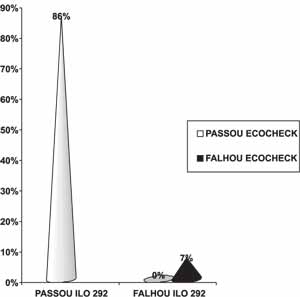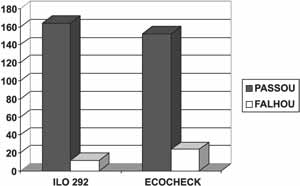

Year: 2003 Vol. 69 Ed. 4 - (17º)
Artigo Original
Pages: 549 to 551
Comparison of otoacustic evoked responses in normal neonates for ILO 292 and ILO Ecocheck
Author(s):
Fernanda C. Scamatti1,
Elaine Soares2,
Luís M. Chiriboga3
Keywords: Deafness, Screeniny otoacustic erussim
Abstract:
The portable equipment (ILO ECOCHECK - AUDX, among others) is another alternative besides the traditional devices (ILO 292 - BYOLOGIC, CELESTA, etc.) for the auditive selection in newborn children. Aim: We have realized transiently otoacoustics emissions with both devices, in 88 normal newborn children without risk of auditive danger to observe the responses gotten with both, determining, this way, the agreement between both devices. Study design: Clinical prospective. Results: We have noticed that the newborn children who failed in ILO 292 also failed in ILO ECOCHECK; however, not all of them who failed in ILO ECOCHECK failed in ILO 292. We have also noticed that the ones who had failed in ILO ECOCHEK had showed us no response in the first analyzable band of frequency of ILO 292. Conclusion: We have concluded that the portable equipament revealed itself more rigorous in the characterization of the normal exam than the criterion of normaity used in the evalution of the conventional exam.
![]()
INTRODUCTION
After the creation of otoacoustic emissions, since it is a quick, non-invasive and objective method, neonatal hearing screening programs increased substantially.
Many authors are concerned about studying the occurrence and effectiveness of otoacoustic emissions, especially in neonates, reason why its use is already part of the routine 1-5.
The search for new devices that could assess otoacoustic emissions was very intense, and as a result of the advance in technology, miniaturization of devices became possible.
There are portable devices available in the market that do not provide so much information as traditional devices, which does not provide reliable data.
The purpose of the present study was to conduct a comparative analysis using both types of otoacoustic emissions devices ILO 292 and ILO ECOCHECK (portable) - in order to observe the responses obtained with both devices and determine the agreement between them.
MATERIAL METHOD
We included in the sample 88 term newborns, with no hearing risk, according to the classification proposed by Azevedo (1996)6 adapted from the Joint Committee Infant of Hearing (1994)7. All subjects were born at Maternidade Campinas. We assessed both ears (right and left) and the results were assessed separately, amounting to a total of 176 exams.
The newborns were submitted to two screenings using evoked transient otoacoustic emissions:
1st using ILO 292 in which we followed the normal range proposed by Chapchap and Segre (1997)8 :
Normal neonates were those that presented general reproducibility ³ 50% and at least 3 out of 4 analyzable bands presented, in accordance with the table above.
2nd Using ILO ECOCHECK in which we considered normal range the presence of the green light, indicative of presence of otoacoustic emissions (as provided by the manufacturers' instruction).
All tests were conducted in soundproof booth. The responses were analyzed concerning presence or absence in both devices.
The result was Pass when the results were within the normal range and Fail when there were no responses.Table 1. Comparison of the responses obtained by the two machines:
Graph 1. Responses obtained by equipment ILO 292 and ILO ECOCHECK.
RESULTS
Based on the analysis of the 176 exams with both devices, we observed that all neonates that failed ILO 292, also failed ILO ECOCHECK, but not all of the ones that failed ILO ECOCHECK failed ILO 292 (as shown in Graph 1 and Table 1).
We could observed that 7% (12) of the exams had absent responses in both devices, 7% failed ECOCHECK, and did not fail ILO 292, according to the normal range criteria defined, showing disagreement in 7%, which was not similar to the results by Ribeiro and Chapchap (1999)9 who found compatible responses in the tested babies. We believe that the size of the sample could have influenced the studies.
Out of 12 newborns that failed ILO ECOCHECK, and did not fail ILO 292, they all presented absence of first band response (ILO 292), that is, according to the normal range criteria the absence in only one band does not mean affection, therefore, the exams had normal results. Since the neonates presented absent responses in the portable device, it demonstrated that the analysis of ECOCHECK considers only the exams that had responses in the four bands, showing that there are more strict parameters in ECOCHECK. It provides safety to the examiner since it is not possible to visualize the bands in the portable device. The device was reliable to conduct otoacoustic emissions in neonatal hearing screening programs, which is in agreement with Ribeiro and Chapchap (1999)9.
CONCLUSION
We concluded after the study that there was disagreement of 7% (12) between the two devices. ECOCHECK presents as normal response only the exam that presents responses in the 4 bands of frequency of the ILO 292 device.
ACKNOWLEDGEMENT
We would like to thank the staff at Maternidade de Campinas who has recognized and supported the importance of our work.
REFERENCES
1. Welzl-Müller K, Stephan K. Confirmation of Transiently Evoked Otoacoustic Emission Based on User-Independent Criteria. Audiology 1994;33:28-36.
2. Dirckx K, Daemers TH, Somers F, Officiers Govaerts PJ. Numerical Assesment of Transients Otoacoustic Emissions (TOAEs) Screening Results: Currently Used Criteria and their Effect on TOAEs prevalence figures. Acta Otolaryngol (Stockh) 1996;116:672-9.
3. Aidan D, Lestang P, Avan P, Bonfils P. Characteristic of Transient-evoked Otoacoustic Emissions in Neonates. Acta Otolaryngol (Stockh) 1997;117:25-30.
4. Lopes Filho O et al. Emissões Otoacústicas Transitórias e por Produtos de Distorção na avaliação da audição em recém-nascidos com poucas horas de vida. Rev Bras Otorrinolaringol 1996;62:220-8.
5. Martin GK, Probst R, Lonsbury-Martin B. Otoacoustic Emissions in Human Ears: Normative Findings. Ear and Hearing 1990;11:106-19.
6. Azevedo MF. Programa de Prevenção e identificação precoce dos Distúrbios da Audição. Processamento Auditivo (Schochat E.) São Paulo: Ed. Lovise; 1996. p. 75-100.
7. JOINT COMMITTEE ON INFANT HEARING Position Statement. Audiology Today 1994;6:6-9.
8. Chapchap & Segre CAM. Triagem Auditiva Universal (TAU): Novo Conceito em Unidade Neonatal. Arquivos Científicos 1997;2(4):134.
9. Ribeiro & Chapchap. Anais do XIV Encontro Internacional de Audiologia 1999.
1 Speech and voice therapist, trainee of the Division of Otoacoustic Emissions, Maternidade de Campinas.
2 Speech and voice therapist, responsible for the Division of Otoacoustic Emissions, Maternidade de Campinas, Professor of Universidade Metodista de Piracicaba.
3 Otorhinolaryngologist, responsible for the Division of Otoacoustic Emissions, Maternidade de Campinas.
Study conducted in the Division of Otoacoustic Emissions, Maternidade de Campinas - SP
Address correspondence to: Elaine Soares Monteiro Pinto - Rua Sud Menucci, 65 apt 82 B
Jardim Aurélia Campinas 13033-180
Tel (55 19) 3242-9277 - E-mail: espinto@unimep.br
Study presented at the International Congress of Audiology - Rio de Janeiro, 2001.
Article submitted on December 12, 2002. Article accepted on June 05, 2003.



